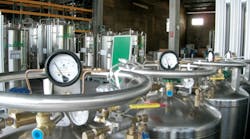An orifice plate is designed to generate a differential pressure of 1,000 mm of water column at a full scale flow rate of 100 liters per minute. What is the approximate flow rate when the orifice plate generates 100 mm of water column?
A. 10 percent of full scale flow
B. 25 percent of full scale flow
C. 33 percent of full scale flow
D. 50 percent of full scale flow
E. None of the above
Commentary
The differential pressure developed across an orifice plate is proportional to the square of the flow. Therefore, one-third flow will generate one-ninth of the differential.
READ ALSO: QUIZ CORNER: How Flow Turndown Affects Measurement Range
Conversely, the flow through an orifice plate is proportional to the square root of the differential pressure developed. In this case, 10 percent of the differential pressure is developed (100/1000), so the flow rate can be calculated as the square root of 0.10, or approximately 31.6 percent of full scale flow.
Additional Complicating Factors This calculation assumes that the orifice flowmeter is designed, installed, calibrated and operated correctly. This is not necessarily the case, especially in gas applications where the gas density is affected by varying operating conditions such as pressure, temperature and composition.
David W. Spitzer is a regular contributor to Flow Control magazine and a principal in Spitzer and Boyes, LLC offering engineering, seminars, strategic marketing consulting, distribution consulting and expert witness services for manufacturing and automation companies. Spitzer and Boyes is also the publisher of the Industrial Automation Insider. Mr. Spitzer can be reached at 845 623-1830 or www.spitzerandboyes.com.
Click on the “Products” tab to find his “Consumer Guides” to various flow and level measurement technologies.


